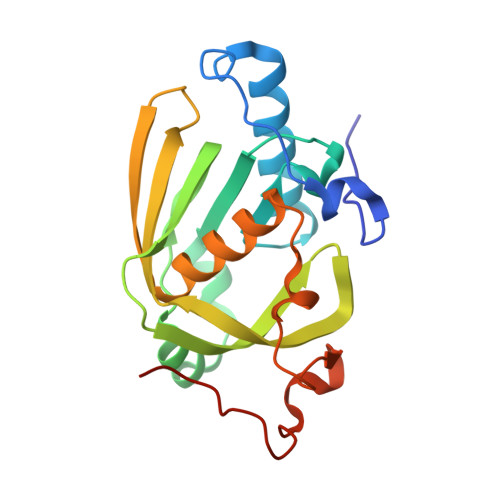The crystal structure of mitochondrial (Type 1A) peptide deformylase provides clear guidelines for the design of inhibitors specific for the bacterial forms
Fieulaine, S., Juillan-Binard, C., Serero, A., Dardel, F., Giglione, C., Meinnel, T., Ferrer, J.-L.(2005) J Biological Chem 280: 42315-42324
- PubMed: 16192279
- DOI: https://doi.org/10.1074/jbc.M507155200
- Primary Citation of Related Structures:
1ZXZ, 1ZY0, 1ZY1 - PubMed Abstract:
Peptide deformylase (PDF) inhibitors have a strong potential to be used as a new class of antibiotics. However, recent studies have shown that the mitochondria of most eukaryotes, including humans, contain an essential PDF, PDF1A. The crystal structure of the Arabidopsis thaliana PDF1A (AtPDF1A), considered representative of PDF1As in general, has been determined. This structure displays several similarities to that of known bacterial PDFs. AtPDF1A behaves as a dimer, with the C-terminal residues responsible for linking the two subunits. This arrangement is similar to that of Leptospira interrogans PDF, the only other dimeric PDF identified to date. AtPDF1A is the first PDF for which zinc has been identified as the catalytic ion. However, the zinc binding pocket does not differ from the binding pockets of PDFs with iron rather than zinc. The crystal structure of AtPDF1A in complex with a substrate analog revealed that the substrate binding pocket of PDF1A displays strong modifications. The S1' binding pocket is significantly narrower, due to the creation of a floor from residues present in all PDF1As but not in bacterial PDFs. A true S3' pocket is created by the residues of a helical CD-loop, which is very long in PDF1As. Finally, these modified substrate binding pockets modify the position of the substrate in the active site. These differences provide guidelines for the design of bacterial PDF inhibitors that will not target mitochondrial PDFs.
- Institut de Biologie Structurale J-P. Ebel CEA-CNRS-UJF, UMR5075, Laboratoire de Cristallographie et Cristallogenèse des Protéines (LCCP/GSY), 41 Rue Jules Horowitz, F-38027 Grenoble Cedex 1, France.
Organizational Affiliation:

















